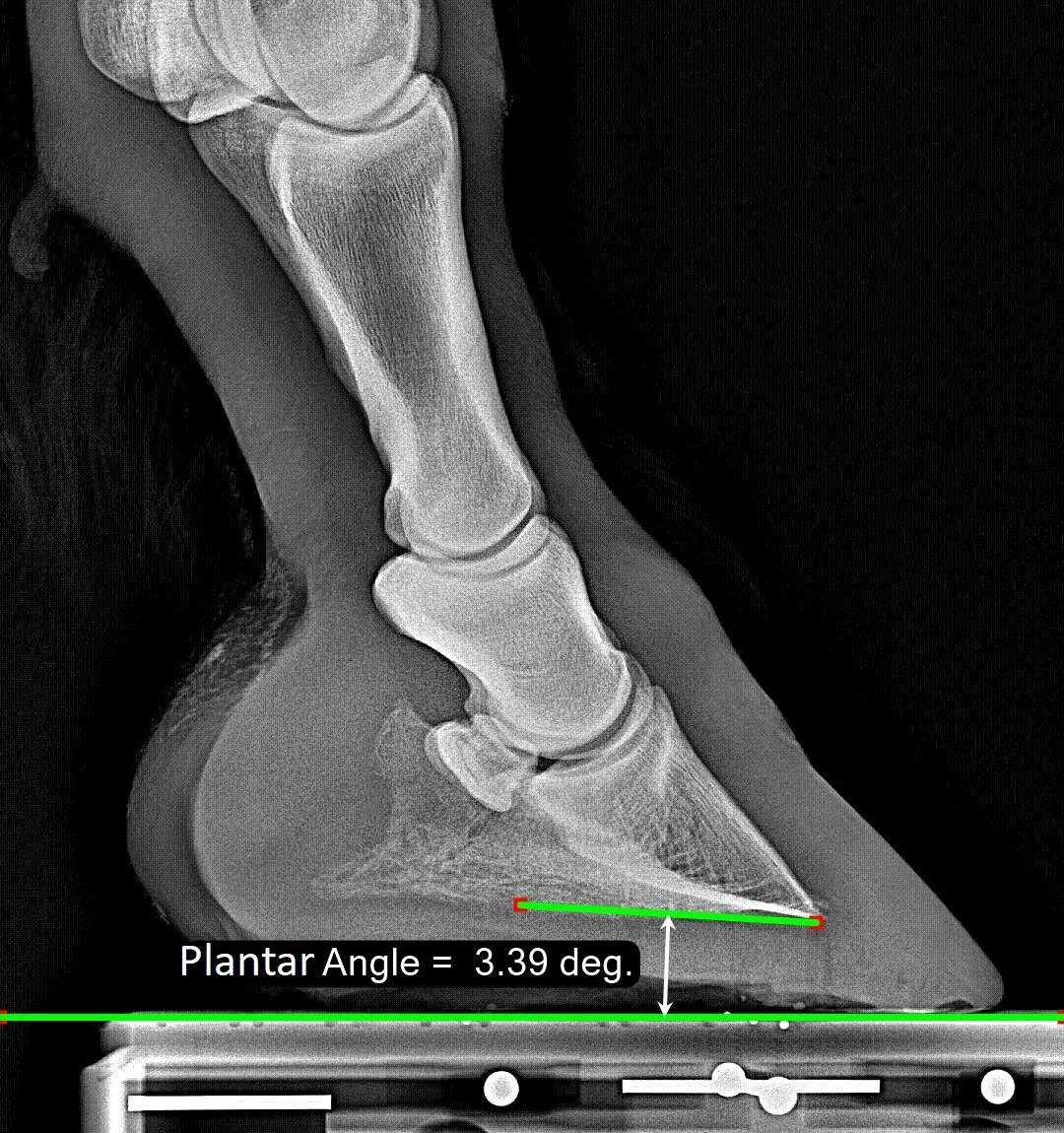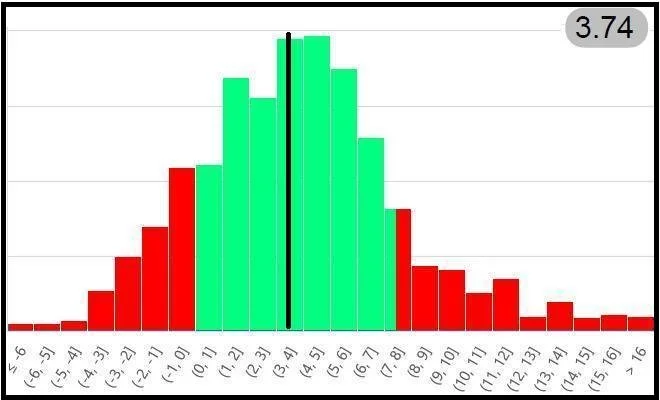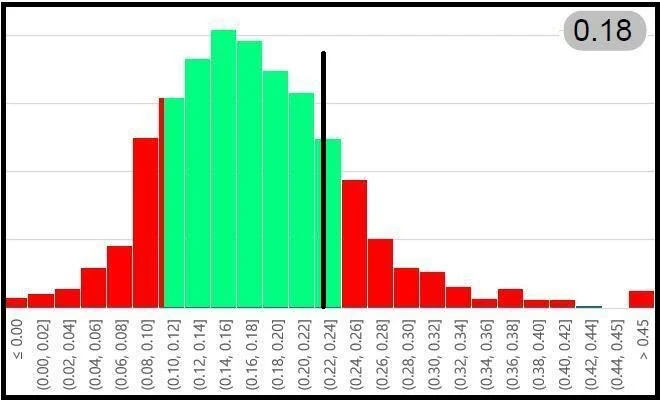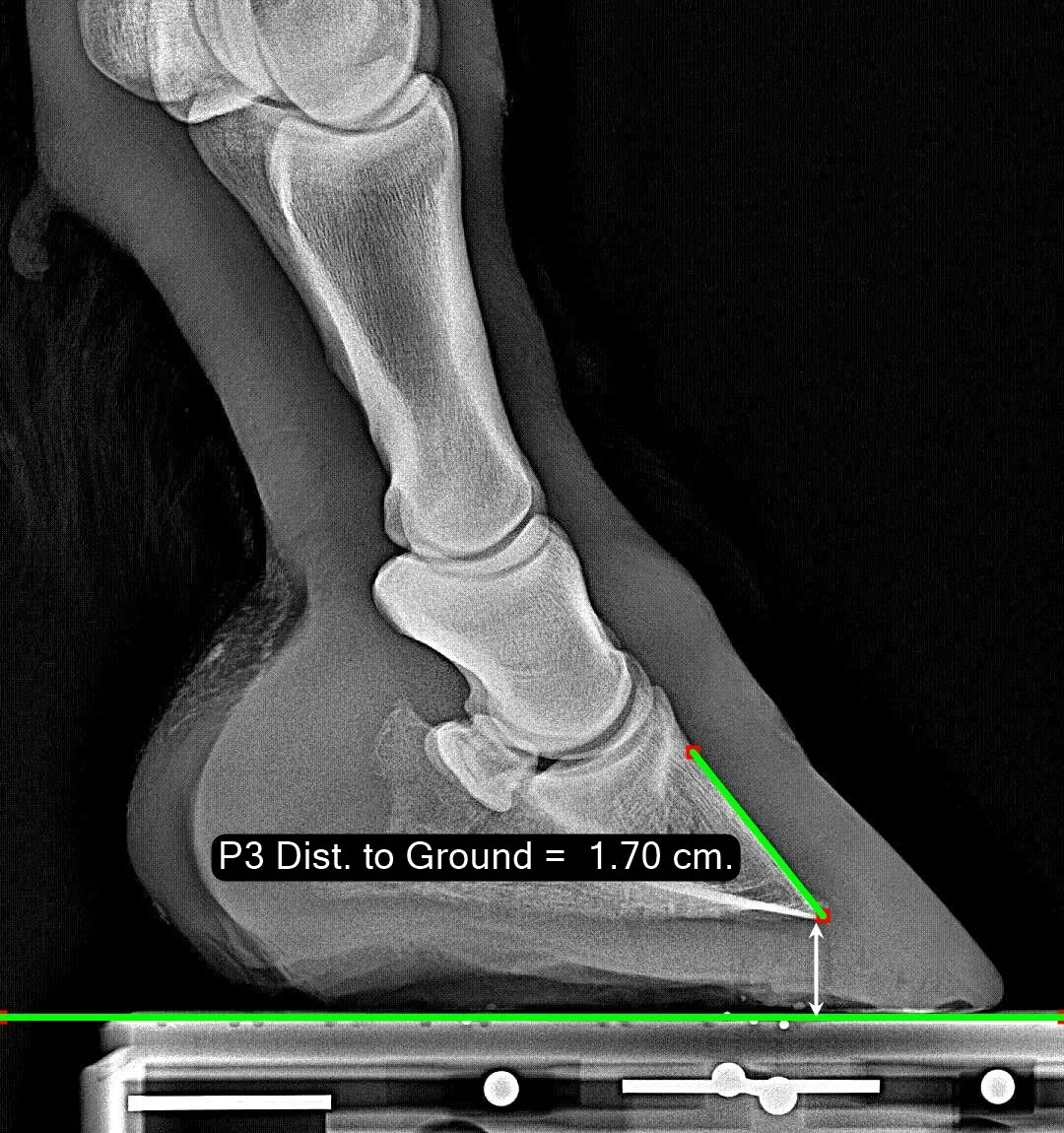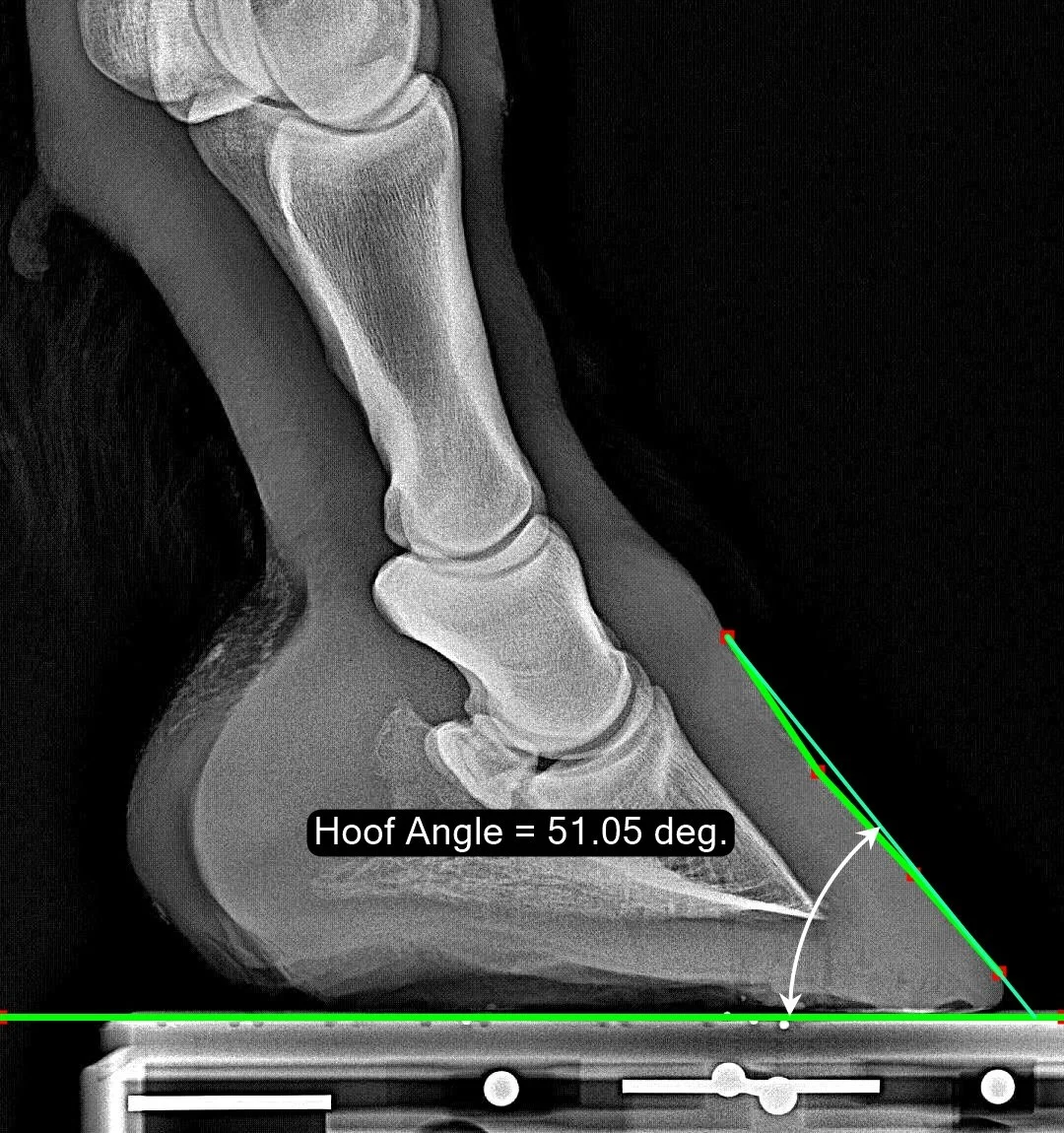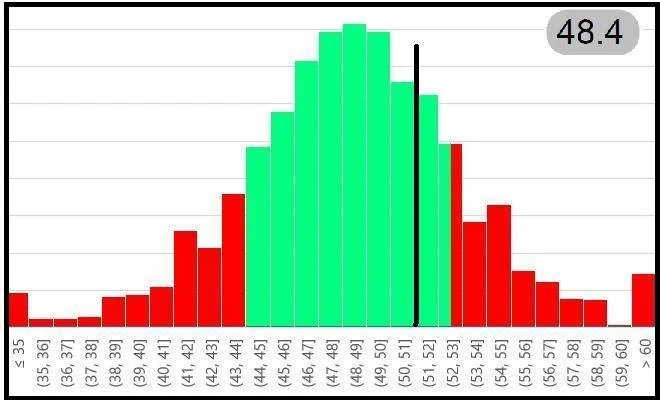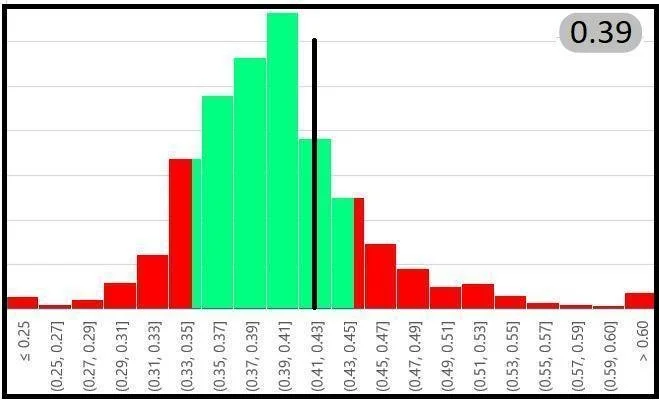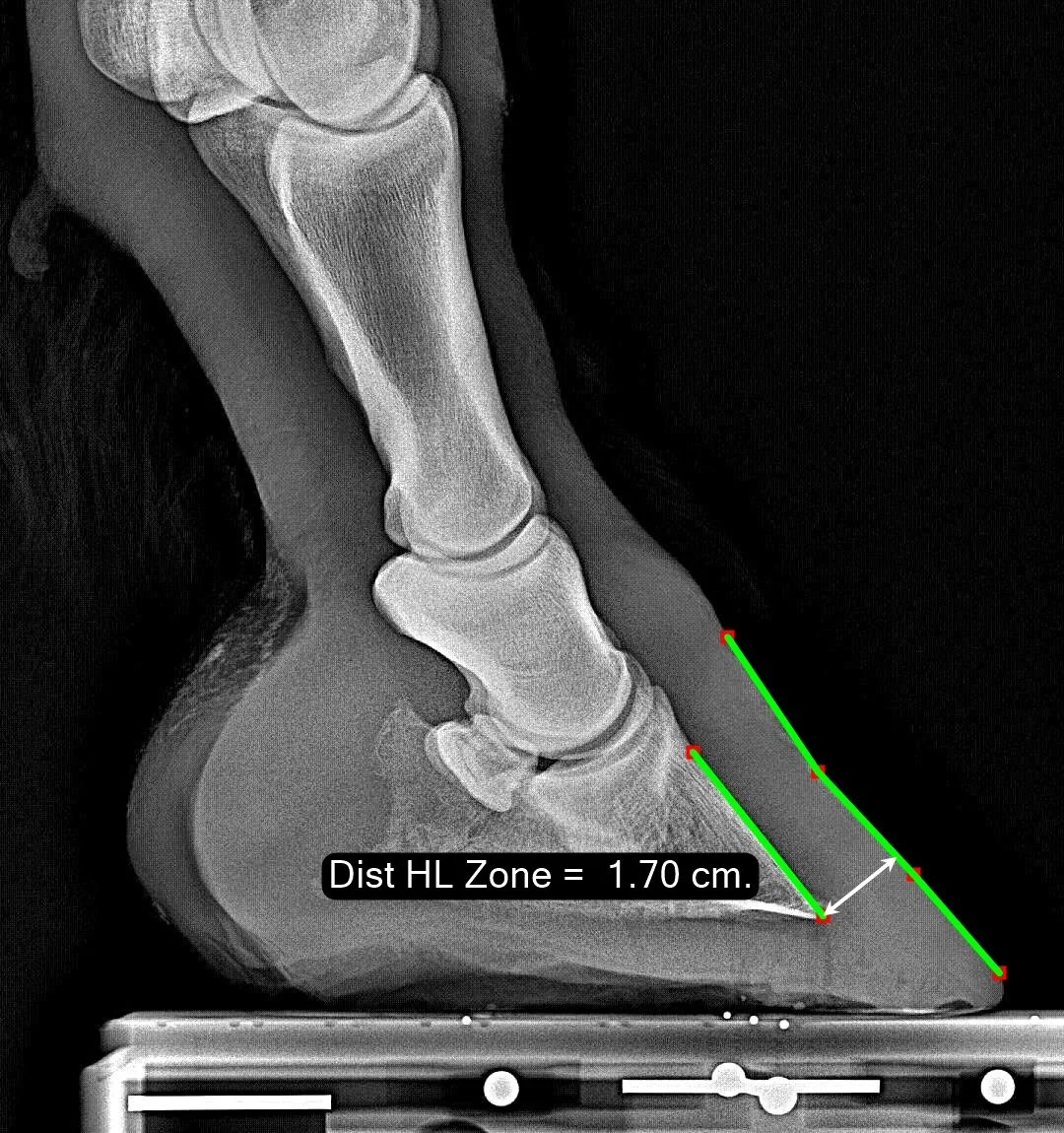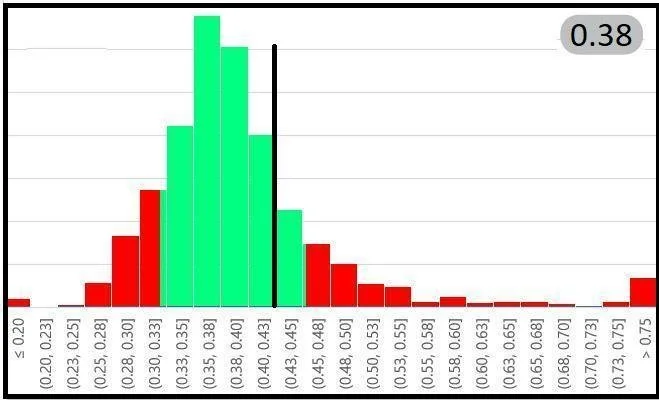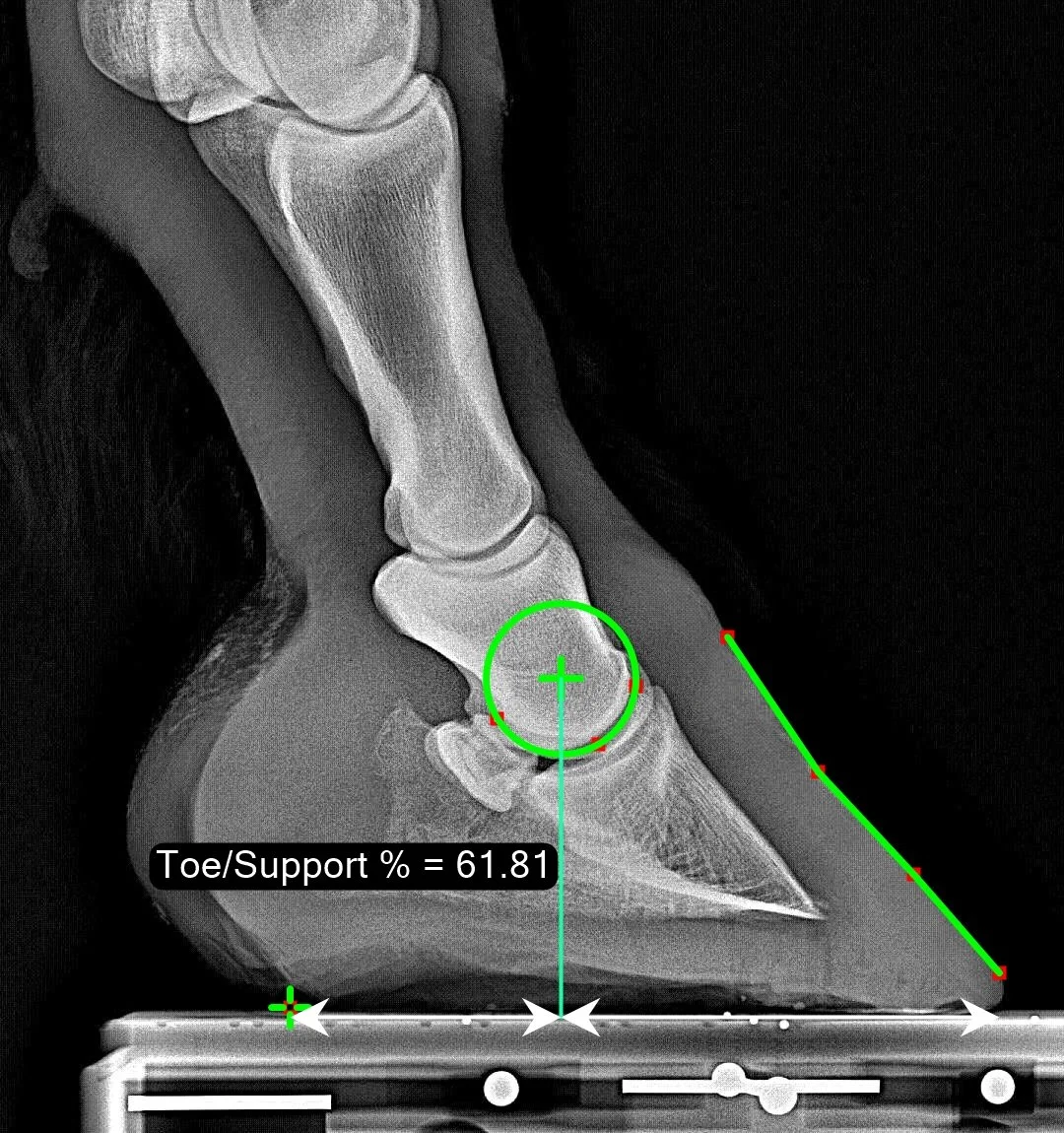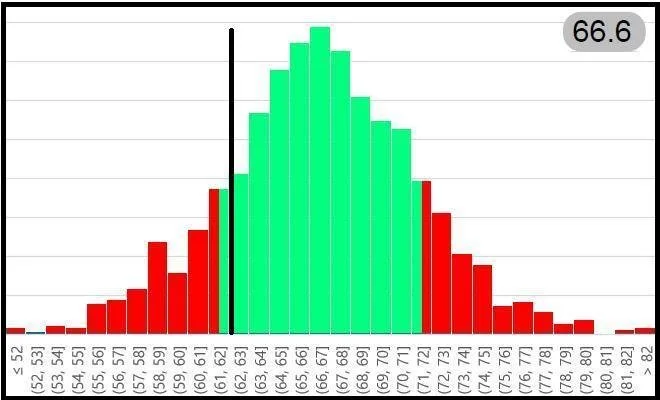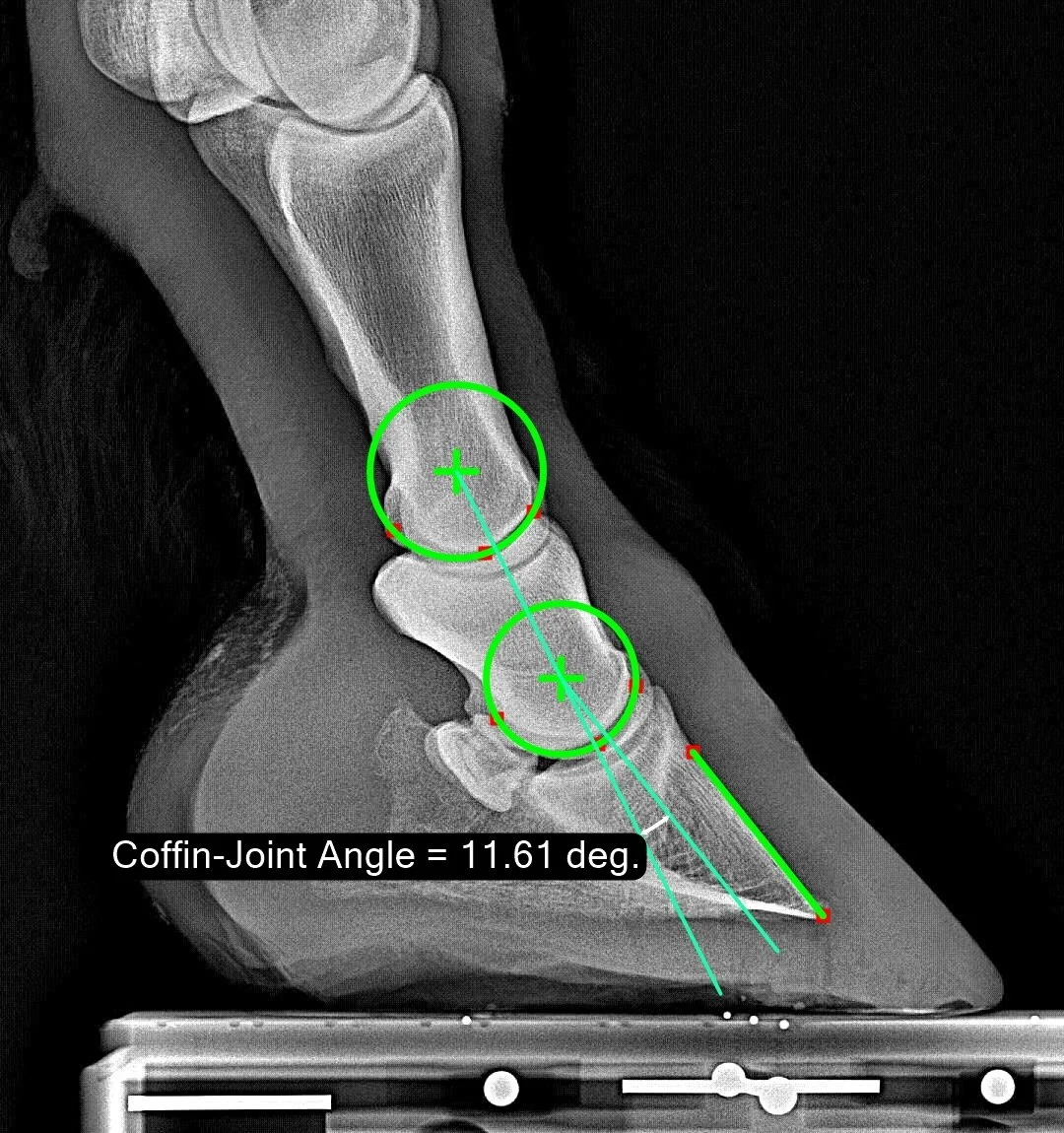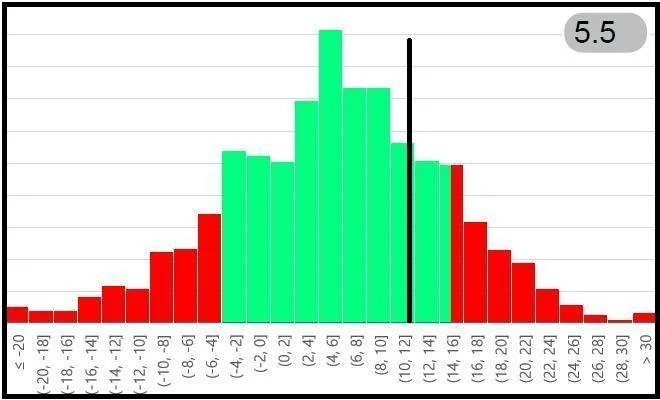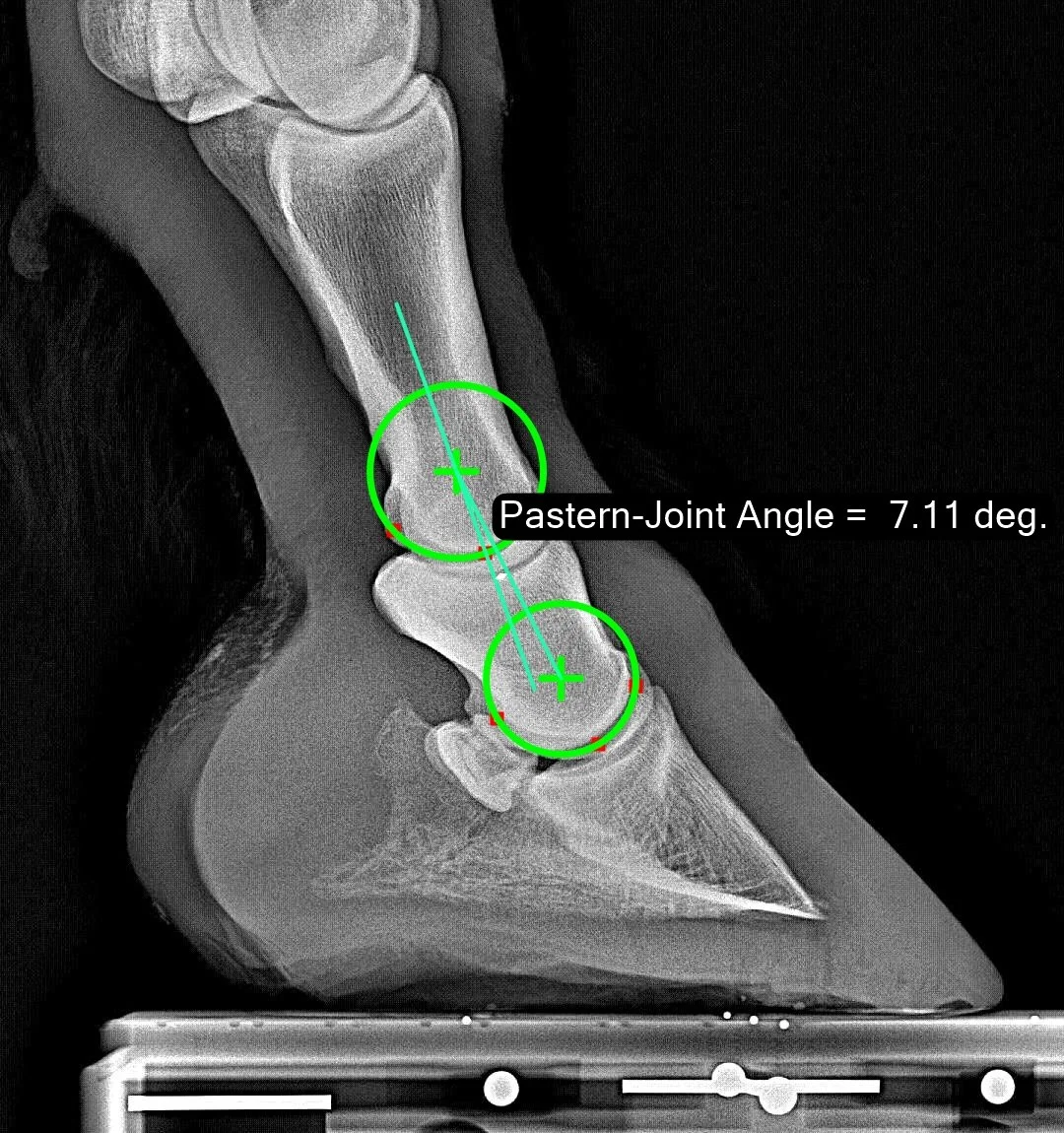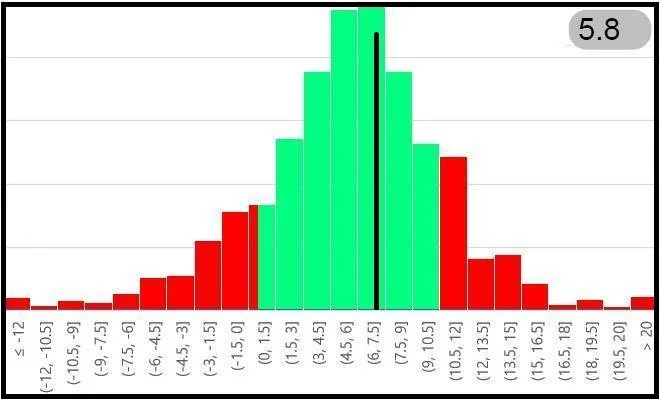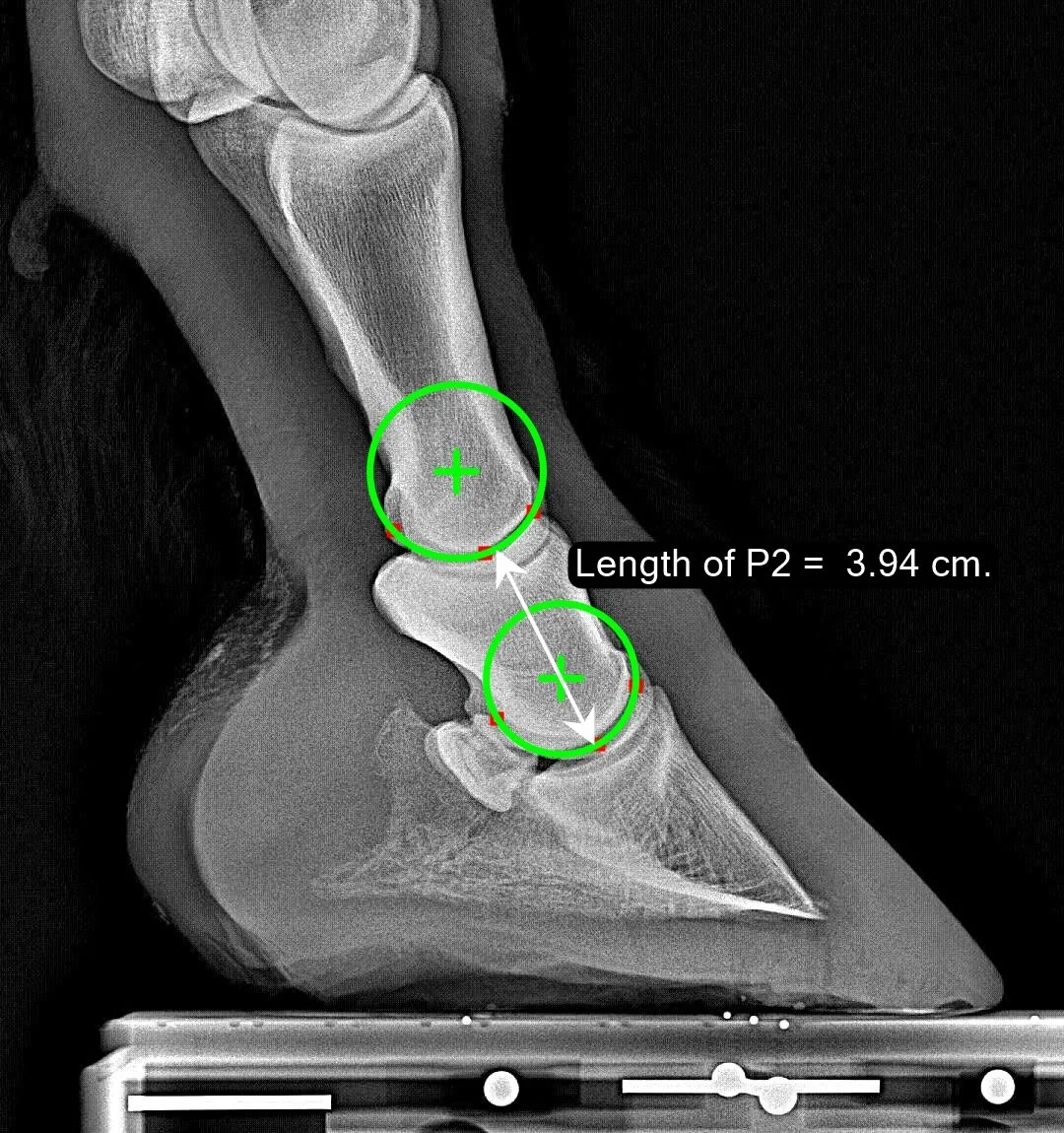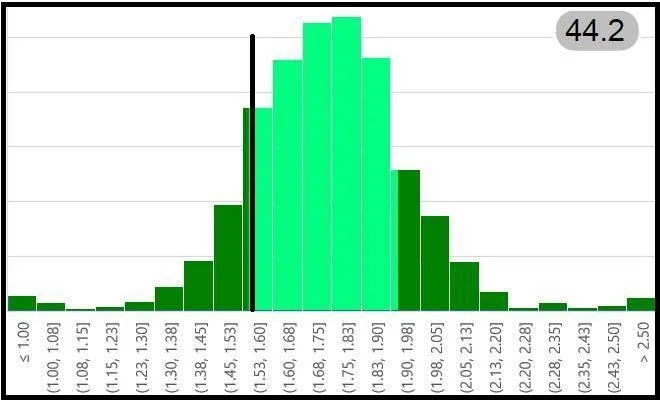Notes on the Statistical Data for Hind Feet Shown in our Reports
The statistical distributions shown in our reports differ for front feet and hind feet. This page documents definitions and statistics for hind feet (a similar page for front feet is here). To gather this information, we used tens of thousands of images from more than 60 veterinary clinics from around the world. Of these, our current reports use data from about 1,700 hind hooves. We believe these are an accurate sample of the population of “horses radiographed by veterinarians”. Hence, the population includes horses with issues, but also images from pre-purchase exams, and images taken for shoeing/trimming purposes. Our only edit made to the raw image data was to remove images in which large wedge-pads or other angulation-changing devices were employed; hence images are barefoot horses or flat-shod horses.
In the distribution graphs, we color the central 70% of horses in green, and show 15% of horses with low value in red, and 15% of horses with high value in red. Roughly speaking, we can say if the value falls in the green range, the measurement is ‘normal’ in the sense that it is in the range we observe for 70% of horses in our population. ‘Normal’ may differ from ‘Ideal’, but ‘Ideal’ is always more or less subjective. By showing actual measurements of a large number of horses, we get a feel for what is ‘Normal’, and our data is quite objective, and can be used by practitioners with varying belief systems.
One caveat related to hind hooves. Because it is often difficult to get the horse to stand squarely with both hind hooves on blocks, we suspect that many of the images in our dataset may have not followed a strict protocol in this regard. The main result of this is that our data on “stance angles” (coffin-joint angle and pastern-joint angle) may be less reliable than we would like. For example, if the opposite leg was lifted (instead of being on a block) it would change the angulation of the leg being radiographed.
Note that image-based measurements give a great evidence base for treatments but are not the whole story. These measures do not capture attributes of soft tissue (bruising, scars, etc) nor the details of the usage of the horse, or past medical history. All clinically relevant data should be used when diagnosing and treating.
Plantar Angle
The Plantar Angle describes the shallow angle between the bottom of P3 and the ground. It grows more positive as the heels are raised. If the heels are very low, the Plantar Angle can become negative.
Normal Range
For a hind hoof, our ‘normal range’ is from -0.2 degrees up to 7.3 degrees, with the median at 3.7 degrees. The black vertical line shows the value for this image. Our reports also show the Plantar Angle on page 1 with the distribution colored by quartiles.
P3 Descent
‘P3 Descent’ is the vertical distance from the hairline to the top of the extensor process of P3. Some publications have called it the ‘Founder Distance’. A large value may indicate that the bone is sinking within the capsule, so smaller values are desirable. Support under the foot may aid to stop or reduce the rate of sinking.
Normal Range
For linear measurements, we scale the value by the ‘length of P2’ which for this image was 3.94 cm. For this example, this yields 0.22. By scaling, we can compare values that are independent of the size of the hoof. The ‘normal range’ is 0.10 to 0.24, with a median of 0.18. That is, 18% of the length of P2 is a normal value for this measure in a hind hoof.
P3 Distance to Ground
This measure is related to sole thickness beneath the tip of P3. Due to varying quality of radiographs, we have not felt that we should expect to be able to see the underside of the actual sole, so rather than trying, we measure “distance to ground” to give an estimate of sole thickness conflated with concavity of the sole. We do not want this measure to be too small.
This distribution is not shown in our reports because within our dataset, some hooves were measured with shoes on, and some were measured barefoot. This makes a single statistical diagram somewhat confusing. In order to avoid that, we leave it out of the report.
See the information on front hooves for a bit more about this.
Hoof Angle
The Hoof Angle measurement is measured as if a physical gauge was laid across the dorsal wall of the hoof starting at the coronary band. This means that a “dish” if the hoof is spanned (as you see in this sample image). On a bull-nosed hoof, this scheme may underestimate the Hoof Angle. The Hoof Angle is only perfectly defined when the dorsal hoof wall is straight.
Normal Range
The ‘normal range’ observed in the population ranges from 44 degrees to 53 degrees, with a median of 48.4 degrees.
Proximal HL Zone
The Proximal Hoof-Lamellar (HL) Zone measures the distance from the dorsal aspect of the P3 bone just below the extensor process out to the outer hoof wall. It is measured perpendicular to the face of P3.
Normal Range
Because this is a linear measurement, in our population distribution graph we divide the distance by the length of P2. For this example image, this yields the value 0.42. Our normal zone is from 0.34 to 0.44 with a median value of 0.39. A normal value for a hind hoof is 39% of the length of P2.
Distal HL Zone
The Distal Hoof-Lamellar (HL) Zone measures the distance from the dorsal aspect of the P3 bone at its tip out to the outer hoof wall. It is measured perpendicular to the face of P3.
Normal Range
Because this is a linear measurement, in our population distribution graph we divide the distance by the length of P2. For this example image, this yields the value 0.43. Our normal zone is from 0.33 to 0.44 with a median value of 0.38. A normal value for a hind hoof is 38% of the length of P2.
Toe/Support Percentage
The Toe/Support Percentage is measured as follows: a vertical line is dropped down from the center of articulation of the coffin joint. Then we measure the percentage of the ‘support length’ of the foot which lies ahead (cranial) to this line. The ‘support length’ extends from the most caudal point where the hard heel meets the ground, up to the most cranial part of the hoof. In the case of a ‘toe bevel’ this might be defined differently but note that we extend it past where the bevel begins and go all the way to the most cranial tip of the hoof. This measure can be thought of as a biomechanically-inspired measure of toe length. A larger value means a longer toe, and a bigger lever arm during breakover.
Normal Range
The normal range we observe is from 61.5% up to 71.5% with a median of 66.6%.
Coffin-Joint Angle
The Coffin-Joint Angle measures the angulation between the P2 and P3 bones. To be precise, it is measured as follows: construct a line connecting the rotation centers of the pastern and coffin joints. Then measure the angular difference between that line and the parietal surface of P3. The details are discussed in this publication. To repeatably quantify a given leg/hoof, it is important to stand the horse with cannon bone approximately vertical when imaging.
Normal Range
The observed normal range is from -4 degrees to 15.0 degrees with a median of 5.5 degrees. This means it is normal (in our population) to be ‘broken back’ by about 5.5 degrees but note the wide spread in values observed in hind hooves. The larger the value, the more ‘upright’ the pastern.
Pastern-Joint Angle
The Pastern-Joint Angle measures the angulation between the P1 and P2 bones. To be precise, it is measured as follows: construct a line connecting the rotation centers of the pastern and coffin joints. Then measure the angular difference between the centerline of the P1 bone and that line. The details are discussed in this publication. To repeatably quantify a given leg/hoof, it is important to stand the horse with cannon bone approximately vertical when imaging.
Normal Range
The observed normal range is from 0.7 degrees to 10.5 degrees with a median of 5.8 degrees. The larger the value, the more ‘upright’ the pastern. At 7.1 degrees, this sample shows a somewhat more upright (or ‘broken-back’) pastern joint angle than average, but still well within our 70%-of-all-horses normality zone.
Length of P2
The Length of P2 is used in our system to scale any linear measurements to remove the dependence on hoof size. This way, we can make statements like “it is normal for the P3 Descent value of a hind foot to be 18% of the length of P2.” Note that the length of P2 as we have defined it is unaffected by the stance of the horse and is unaffected by trim alterations to the hoof. The precise definition is: measure the distance between rotation centers of the pastern and coffin joints, then add the radius of the coffin-joint circle and subtract the radius of the pastern-joint circle. The result (drawn in white below) is the ‘Length of P2’.
Normal Range
The 15% wings of our distribution graph are not colored red for this parameter, as there nothing wrong with being a small horse or a large horse. We see that the median horse in our dataset has a hind hoof P2 length of 44.2 mm (1.74 inch).
Note: Internally the Metron hoof measurement system actually defines 22 different measures for the lateral hoof radiograph. In the recent evolution of Metron we decided to simplify down to the most important 10 measures, so as not to overwhelm our users. But additional parameters may be added in the future, and we always welcome input from our user community on what they’d like to see.

